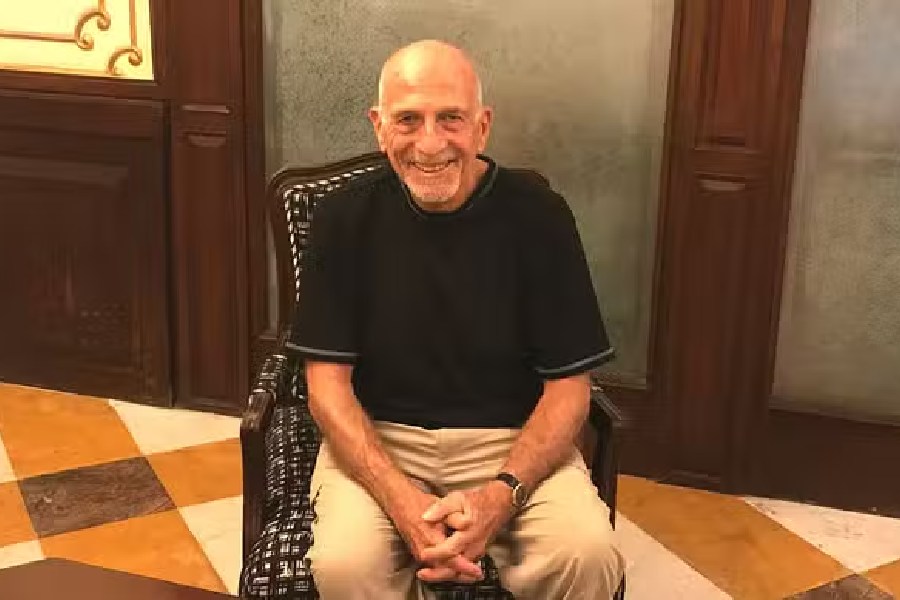If there is a single factor that brings together cultures and time frames as disparate as the ruined capital city of Hampi Vijayanagara in Karnataka, which between 14th and 16th centuries became one of the largest international urban centres, and the terracotta temples of Bengal that were constructed between the 16th and the 19th centuries, it is George Michell, a world authority on South Asian architecture.
Michell, who lives in London, arrived in Calcutta from Delhi on Thursday afternoon after a gap of 20 years. He is here on an invitation from the Tarun Mitra Memorial Lecture Committee of the American Institute of Indian Studies.
Michell will deliver a lecture titled “In the Footsteps of David McCutchion: Brick Temples of Bengal” at the Jadunath Bhavan Museum and Research Centre of the Centre for Studies in Social Sciences on Friday evening. The next evening Michell will speak on “Splendours of Hampi Vijayanagara” at the Birla Academy of Art & Culture.
Born in Melbourne in 1944, Michell obtained a Bachelor of Architecture degree from Melbourne University in 1968. He then turned his attention to India and obtained his PhD in 1974 from the School of Oriental and African Studies, University of London, for his dissertation on the early Chalukya temple architecture.
In an interview on Thursday afternoon, Michell recalled those heady times in January 1980 when he worked with a motley group in what was then uncharted territory in Karnataka — the ruins of the “Victory City”, one of the great Hindu empires.
“There was nowhere to stay, there was nothing to eat,” says Michell, when an “improvised group” of students and archaeologists and John Gollings, an Australian architectural photographer, together began the process of unveiling the marvels of the ancient Hindu capital that had lain undisturbed after its collapse in early 17th century.
Then a girl arrived with her boyfriend on a motorbike. She was a banker but decided to stay on. Sugandha Purandare ended up doing a Phd in archaeology and wrote a book on Ahilyabai Holkar. A German hippy, Wolfgang, a student of Sanskrit at the University of Munich, was there too. Also present was Snehal, a student of architecture from Ahmedabad. There he met Arthur, an Irish architect. Arthur accompanied Snehal to Ahmedabad and started on his own.
“That was the magic of Hampi. It shows how people end up working together,” says Michell, a wonderful raconteur.
When the first phase was over, he went to meet Mulk Raj Anand, who edited Marg magazine, to convince him to publish a volume on Hampi. He was “not very excited”. But when Anand visited the archaeological site he “loved it” and published a volume the next year.
When Michell went back to London he got a call from an American archaeologist named John M. Fritz. Michell showed him some preliminary sketch maps of Hampi and he was fascinated. They were back in Hampi in 1981 and Fritz “got involved”.
Before that, Michell got a phone call from Robert Skelton, who was the curator in the Victoria and Albert Museum, London. Skelton said a man had come with a box of 60 waxed negatives dated 1856. They turned out to be photographs of Hampi by
an English colonel named Alexander Greenlaw.
When Michell was in Hampi for the second season, Nagaraja Rao, director of
the Karnataka State Archaeology, dropped by. He saw them working under the
open sky and took them to meet his boss, the secretary of culture.
Consequently, from 1982 — the third term — they began to live in camps with the state archaeology staff. Thereafter, for 20 long years, they came back every year with different groups of students. Michell has been involved in different projects, and has written a wide range of books from monographs to guide books.
By that time Michell had finished his “big book” on David McCutchion (1930-1972), the pioneering scholar
who taught comparative literature at Jadavpur University and made a major contribution to the study of terracotta temples of Bengal. Vijayanagara and the terracotta temples are “interlocked”, says Michell.
When McCutchion was on a rare visit to London, Robert Skelton had encouraged him to get a better camera. He had bequeathed his photographic archive to Skelton. After McCutchion’s death, it took several years for the archive to reach Skelton. The New York-based J.D. Rockefeller III had informally agreed to fund McCutchion.
But McCutchion died in 1972 around the time Michell was finishing his dissertation on Chalukya architecture. Although Michell had no clue about Bengal temples, the project went to him.
Michell spent three years in West Bengal and Bangladesh — 1978, 1979 and 1980. Michell had the advantage of being an architect by training. So with the help of Sambhu Mitra, a civil engineer, Michell produced maps of the brick temples. The result was Brick Temples of Bengal: From the Archives of David McCutchion. Edited by George
Michell, the Princeton University Press publication has for long been out of print. Now a facsimile copy of the book will be published by Niyogi Books.











